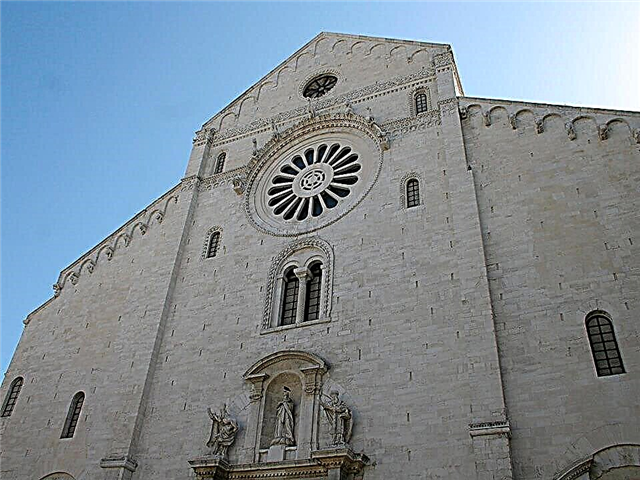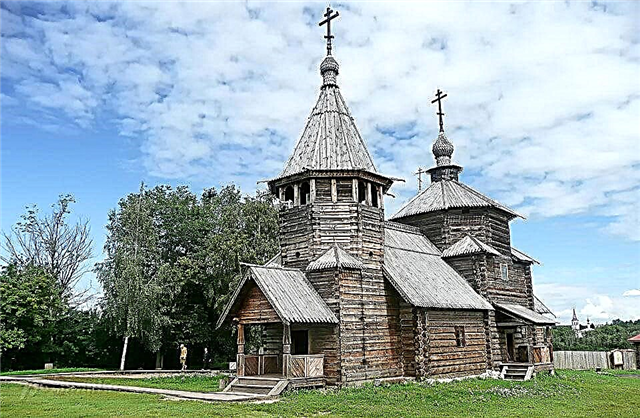Address: Russia, Nizhny Novgorod region, Nizhny Novgorod, Pochainskaya street, 27
Build date: late 17th century
Coordinates: 56 ° 19'31.6 "N 43 ° 59'42.4" E
Content:
The oldest monument of urban civil architecture was erected in the 17th century. There is a historical legend that it was here that Tsar Peter I stayed when he first visited the city on the Volga. Thanks to the two-story white-stone house, we can understand what the rich merchant housing looked like in Nizhegorodsky Posad.

General view of the House of Peter I
Peter I in Nizhny Novgorod
The young Russian Tsar Peter I first came to the city in mid-May 1695. This happened when he was heading to the Azov campaign. Together with the sovereign on wooden plows, the soldiers who accompanied the transported artillery sailed to the city. And the main army was on foot.
Bad weather forced the tsar to stay in the city longer than planned, and Peter I lived in Nizhny Novgorod for a whole week. At this time, the cannons from the Kolomna plows were reloaded for nine pauses, adapted for sailing along the Volga. This happened because at the end of spring the water in the river was still high, and the tsar considered it rather risky to sail with a heavy load on small ships. In addition, in the city, the Russian army replenished the stocks of provisions.
Although the history of the Tsar's stay in Nizhny Novgorod is known for a rather detailed description, there is not a single documentary evidence of which house he lived in. It is believed that these were stone chambers that belonged to the Nizhny Novgorod merchant Efim Chatygin.
The second time the Russian tsar visited Nizhny Novgorod in the spring of 1722, when he set off on a military campaign against Persia. This time he stayed with a local merchant Yakov Pushnikov.
In 1838, the white-stone building - Chatygin's house - was painted by Russian painters brothers Nikanor Grigorievich and Grigory Grigorievich Chernetsov. Their drawing became the first depiction of an architectural monument.

View of the southeast facade of the building
The history of the Chatygin merchants' chambers
In the second half of the 17th century, the construction of a stone building was very expensive. It cost about 15 times more than a wooden one. And even taking into account the fact that fires were frequent in villages and cities, the construction of stone dwellings was not profitable. That is why there are so few civil buildings erected before the beginning of the 18th century. Nowadays, in Russian cities and towns you can find no more than five dozen such buildings.
The exact date of the construction of the house of Peter I is not known. Presumably this happened in the 1680s. The white-stone chambers were built of large-sized bricks and plastered with white lime. They looked rich, solid and elegant. Originally a wooden gallery adjoined the house on the north side. And the staircase connecting the floors was in this annex.
At the beginning of the 18th century, the building was owned by the Dokukin merchants, and later the owners of the building changed frequently. In the 1840s, the house housed a wine warehouse. A guidebook, published in the middle of the 19th century, informed the guests of the city that a certain Mr. Polz owned the stone building, and since 1865 - his widow, who rented out the premises for a beer warehouse.
Twenty years later, thanks to a new mistress, a Nizhny Novgorod bourgeois woman, Rachel Shprits, an overnight house for vagabonds was opened in the building. The famous Nizhny Novgorod public figure and writer Alexander Serafimovich Gatsisky was outraged by this fact, and he began to seek the redemption of the historic building by the city. This happened in 1888. For the house, 10,000 rubles were paid, which were allocated by the Nizhny Novgorod merchant Nikolai Aleksandrovich Bugrov, and the scientific archival commission of the Nizhny Novgorod province became the new owner of the building.

Main entrance to the building
The old house was restored under the guidance of the provincial engineer Nikolai Pavlovich Ivanov. The city authorities spent 5 thousand rubles collected from private donors for the repair of the building and the arrangement of the interior. On the western side, a porch "in the Russian style" was added to the house, made in the traditions of pre-Petrine architecture. The builders placed polychrome tiles removed from the ancient Sergievskaya church on it. Old windows were hewn and new ones were cut. The platbands made of carved stone were knocked down and replaced with plaster parts. As a result, despite all efforts, the appearance of the architectural monument was significantly distorted.
In 1895, a historical exposition was opened inside the building, which consisted of 1,359 items. Here one could see artifacts found during archaeological excavations, ancient weapons, armor, coins, household utensils, paintings, as well as church values. However, this museum did not last long and was soon transferred to the Dmitrievskaya tower of the Nizhny Novgorod Kremlin. And in the white-stone chambers they left a repository of antiquities and opened a free library-reading room for everyone.
But soon the reading room was closed, and before the revolutionary events of 1917, the building housed the classrooms of the city river school. Then several families of Nizhny Novgorod residents lived inside the historic building. In the 1970s, a large-scale restoration was carried out here, preserving the porch added in the 19th century. The works were supervised by the well-known architect-restorer S.L. Agafonov.
Since 1973, the local branch of the Society for the Protection of Monuments has been located in the white-stone chambers. Then there was a bar and a restoration center in the building.

View of the southwest facade of the building
The current state of the building and the visiting regime
The white-stone chambers is a two-storey house with two rooms, in terms of which it resembles the letter "g". Each room is covered by a closed vault. There are spacious basements under the building with a ramp-down. Windows on each floor are decorated with multi-profile keeled platbands.
From the north, the foundation of the massive building is reinforced with a brick retaining wall. In the mid-1990s, a memorial sign was fixed on the wall of the building - a high relief depicting Peter I. Since 2008, the house has the status of a cultural heritage site. By the end of 2015, it was overhauled. Inside the historic building, you can see an 18th century tiled stove, a cast-iron staircase and antique stucco decoration.
How to get there
The white stone chambers are located in the city center, at 27 Pochainskaya Street. The historic building can be reached by trams (stop "Dobrolyubova Street").











